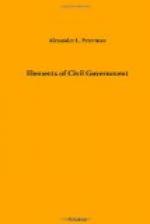As a person may be at the same time a citizen of a village, a township, a county, a State, and the United States, so he may, during the same year, pay a separate tax to each of these five governments.
NECESSITY OF TAXATION.—Taxation is one of the necessary burdens of society. A government as well as an individual must have money to pay its expenses, and the principal part, if not all, of this money must be raised by taxation of one kind or another. Men may differ as to the kind and the rate of taxation, but taxes must be paid in order that government may exist. The tax payer receives no immediate return for his taxes, but has a constant return in the way of protection to life, liberty, and property, the enjoyment of public conveniences, and the improvement of society.
By means of taxes each person bears his part in the cost of maintaining the social compact. He gives up a portion of his property in order that what remains may be the more secure and valuable, and that he may enjoy many other blessings that would otherwise be impossible. Although the rate is often high, even higher than necessary, it is safe to say that every tax payer of the country receives from the government more than he contributes by taxation.
Taxes are direct or indirect.
DIRECT TAXES.—A direct tax is levied directly at a given rate upon property or polls. Taxes levied by villages, towns, townships, cities, counties, and States are for the most part direct taxes.
A poll tax is levied upon the polls, or heads, of the male inhabitants who have attained a certain age, usually twenty-one years.
A property tax, as the name indicates, is levied upon property. Property is of two kinds, real and personal.
Real property, usually called real estate, consists of lands and buildings.
Personal property is that which can be moved from place to place, and includes everything that a person can own except real estate.
In all systems of taxation, much real estate, such as churches, cemeteries, colleges, charitable institutions, and public buildings, is exempt from taxes.
Five times in its history—namely, in 1798, 1813, 1815, 1816, and 1861—the United States levied a direct tax upon the people, but in each case the law was in force but a single year. From 1861 to 1871 there was also an income tax; that is, a tax of a given per cent. upon all annual incomes that exceeded a certain amount. In 1913, Congress passed a new income tax law, with additional taxes on very large incomes.
INDIRECT TAXES.—An indirect tax is assessed upon the property of one person, but is indirectly paid by another. The owner of the property at the time of assessment pays the tax to the government, but a part or all of the tax is ultimately paid by the consumer of the goods. All taxes now levied by the national government are indirect.




